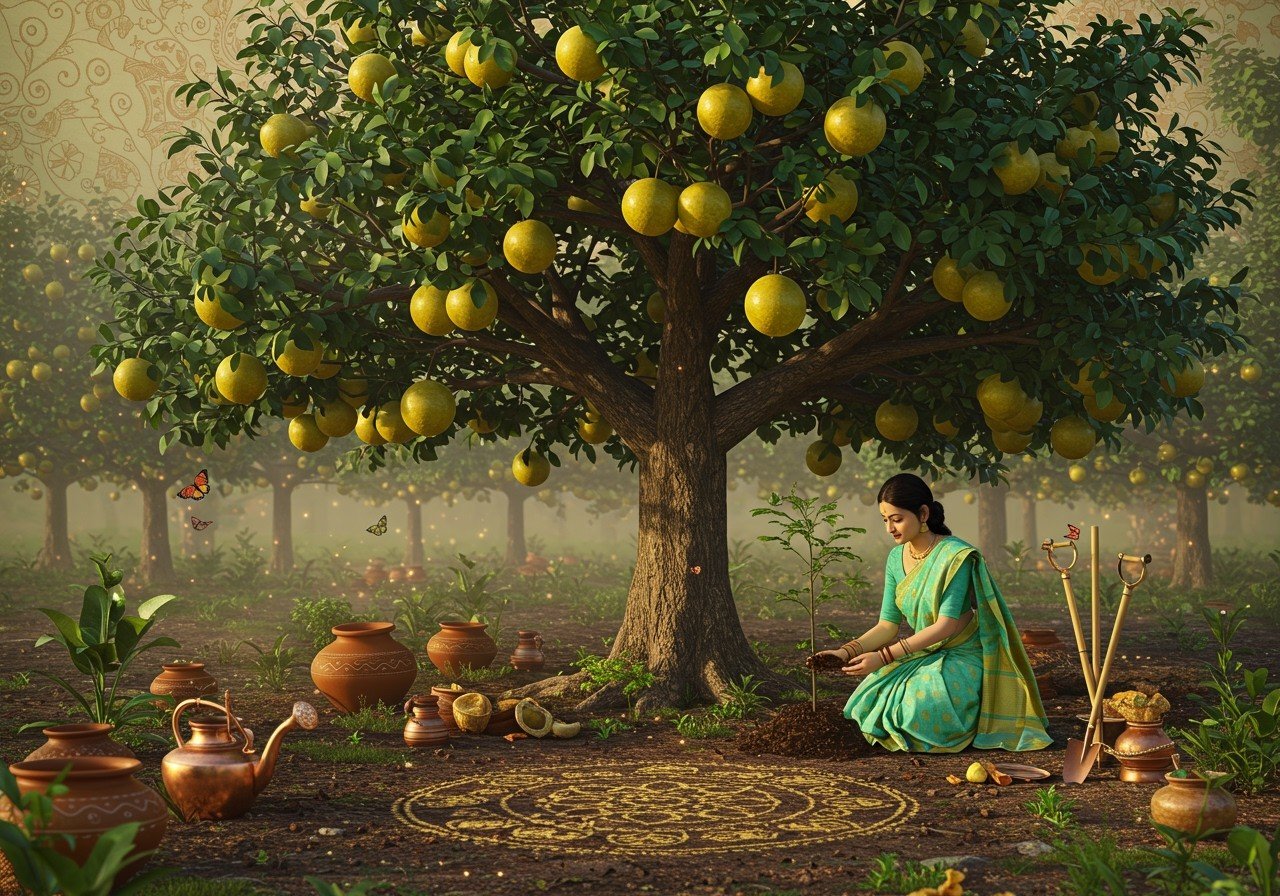
The Bael tree, scientifically known as Aegle Marmelos, holds a revered place in Indian culture and traditions. Celebrated for its significance in religious rituals, Ayurvedic medicine, and its nutritious fruit, the Bael tree offers a wealth of benefits. This comprehensive guide provides valuable insights into the growth and care of this sacred tree, tailored for those who cherish authentic practices and appreciate the convenience of modern resources.
Understanding the Significance of the Bael Tree
The Bael tree, also known as the Bilva tree or Bengal quince, is deeply rooted in Indian heritage. Native to the Indian subcontinent and Southeast Asia, this resilient tree thrives in diverse Indian environments, including arid and semi-arid regions. Beyond its spiritual importance, the Bael tree plays a crucial role in traditional medicine and ecological balance. Its leaves, fruit, and bark are valued for their medicinal properties in Ayurveda, and the tree itself contributes to biodiversity by attracting various bird species. Revered as sacred to Lord Shiva, its trifoliate leaves symbolize the divine trinity, enhancing its cultural and spiritual value.
You can explore our range of sacred plants at poojn.in.
A Step-by-Step Guide to Growing and Caring for Your Bael Tree
Growing a Bael tree is a rewarding experience, connecting you with nature and tradition. Here’s a detailed guide to help you nurture this sacred tree:
1. Climate and Location: Creating the Ideal Environment
- Warmth and Sunlight: The Bael tree flourishes in warm, subtropical to tropical climates, basking in the abundant Indian sun. Ensure your tree receives at least 6-8 hours of direct sunlight daily for optimal growth and fruit production. While it loves the sun, young plants may need protection from extreme temperatures, both hot and cold. Providing some shade during scorching summers can prevent sun damage, and shielding them from temperatures below 4°C is crucial for their survival.
- Hardiness and Transplanting: Once established, the Bael tree displays remarkable resilience, tolerating drought and high temperatures. The best time to transplant a Bael sapling is during early to mid-summer, allowing it to establish itself before the harsher weather sets in.
2. Soil: Nurturing the Roots
- Soil Type and pH: The adaptable Bael tree tolerates various soil types, even thriving in swampy, alkaline, and stony soils. Though adaptable, it prefers a well-drained sandy loam soil for optimal growth. It also tolerates a wide pH range, from slightly acidic to slightly alkaline (5.5-8.5), showcasing its adaptability.
- Drainage and Soil Mix: Good drainage is essential to prevent waterlogging, which can harm the Bael tree’s roots. Improve soil structure and drainage by adding organic matter. A recommended soil mix includes garden soil (60%), sand or perlite (20%) for drainage, and compost (20%) for nutrients. Additionally, Bael trees exhibit tolerance to salinity up to 9 dsm-1. They can be grown in saline, sodic and sandy wastelands provided the soil is treated with gypsum and pyrite before plantation..
3. Propagation: Starting Your Bael Tree Journey
- Seeds: The Best Method: The most effective way to propagate a Bael tree is through seeds. Collect seeds from ripe fruits, soak them in water for 24 hours (changing the water daily) to enhance germination, and sow them in prepared beds with well-drained soil. Consistent moisture is key for successful germination..
- Cuttings: An Alternative Approach: Propagation through cuttings is also possible. Plant cuttings in well-draining soil enriched with organic matter. Using a rooting hormone can help encourage root development. Keeping the cuttings in a shaded area initially helps protect them while they establish themselves.
Find high-quality holy seeds at poojn.in to start your Bael tree journey.
4. Planting and Transplanting: Giving Your Bael Tree a Good Start
- Preparing the Pits and Soil Mixture: When transplanting, dig pits of size 90cm x 90cm x 90cm. Prepare a nourishing soil mixture by blending garden soil with 25kg of Farm Yard Manure (FYM), 1kg of Neem oil cake (for natural pest control), and 1kg of bone dust (for essential nutrients). After placing the sapling in the pit, water thoroughly to settle the soil and ensure good contact with the roots.
5. Watering: Balancing Moisture and Drought Tolerance
- Watering Schedule: Once established, Bael trees are remarkably drought-tolerant. Watering once every two weeks is generally sufficient. However, during dry seasons, ensure adequate watering to prevent stress, while always avoiding waterlogging, which can be detrimental to the roots.
Poojn.in offers a variety of pure copper vessels ideal for watering your Bael tree.
6. Fertilizing: Nourishing Growth
- Fertilizer Type and Schedule: Support healthy growth by applying a balanced, slow-release organic fertilizer every three months. A fertilizer with an N-P-K ratio of 10-10-10 is generally recommended for balanced nutrition.
You can find suitable organic fertilizers for your Bael tree at poojn.in.
7. Pruning: Maintaining Shape and Health
- Pruning Techniques and Timing: Regular pruning helps maintain the Bael tree’s size and shape, promoting healthy growth. Remove dead, diseased, or crowded branches to improve air circulation and prevent the spread of diseases. The best time to prune is during the dormant period.
8. Potential Problems: Protecting Your Bael Tree
- Pests and Diseases: Be vigilant against common pests like aphids and mealybugs, and use organic pest control methods if necessary. Keep an eye out for diseases like fruit canker and sooty mold. Early detection and treatment are vital for maintaining the health of your Bael tree. Waterlogging can also be a problem, so ensure good drainage.
9. Other Considerations: Interesting Facts about the Bael Tree
- Unique Characteristics: Bael trees have some fascinating qualities. They can act as indicator plants for tracing underground water sources. Also, seedling trees take 7-8 years to produce flowers, while grafted ones start flowering as early as 3 years, a significant difference to consider when planning your Bael tree garden.
Embracing the Bael Tree in Your Life
Bringing a Bael tree into your life is more than just cultivating a plant; it’s embracing a piece of Indian heritage. This sacred tree intertwines tradition, health, and spirituality, offering a wealth of benefits. From its refreshing and nutritious fruit to its sacred leaves used in religious rituals, the Bael tree connects us to our roots while enriching our lives in countless ways.
Poojn.in, India’s leading provider of spiritual and ritualistic items, offers a wide range of authentic puja samagri and jari booti to support your spiritual practices.


